|
It was a long way from the Moremi
Gate to our camp. We were following a wet road through the woods;
it seemed to be a different route than we had taken in the past,
but perhaps it just looked different in the rainy season. There
were many puddles in the road, and some of them were huge.
Gee let me drive! He had had been
behind the wheel for eight hours when to my surprise he asked if I
wanted to drive for a while, to give him a break. Wow! I don’t
know if he really needed a break, or was just being nice letting
me have a go at the wheel, but I jumped at the chance!
I didn’t find the land cruiser too hard to drive; I am
used to driving my truck and horse trailer, and I am comfortable
shifting gears. I have driven in England enough that I am also
comfortable driving on the left side of the road – though these
roads were not really big enough to be on one side or the other,
and besides the ranger we had not seen another vehicle all day. At
first I was shifting a bit rough, and I had to sort out which
gears to use, but as I went I got better, and the ride got
smoother.
I navigated quite a few huge
potholes filled with water; and by huge, I mean they stretched
across the whole road, and were often three or four feet deep. The
key seemed to be to not fight the steering as you negotiate these
craters, but to keep your hands loose and relaxed on the wheel.
There was much laughter at my
driving and guiding skills. Paula said, ‘OK, now we expect you
to be driving, spotting leopards, avoiding potholes, and pointing
out birds we haven’t seen before.’ I braked to a stop, pointed
up to the left and called out, ‘New bird!’
I drove through a beautiful area
of big trees and meadows. We did see a new bird, the Crested
Barbet – though it was Gee that pointed it out and not me. Then
we came to an enormous pothole filled with water, bigger than all
the rest; it must have been eight feet deep and would be like
crossing a pond. I gladly let Gee take over the wheel again.
I am not sure how relaxing a break
Gee had while I was driving, but I thought it really was fun, and
I was honored that he trusted me to drive.
With Gee driving again, we passed through a mopane forest.
We were used to seeing these trees broken and stunted after being
eaten by elephants, but here they grew tall and majestic. Gee told
us the mopanes love the soil and rain in the Delta, and grow well
there. Elephants can’t eat them all. The beautiful trees are
used for building and for firewood.
A bird of prey sat high in a tree
while we tried to identify it; after much debate and comparing our
close up photos with the bird book, we decided it was a Booted
Eagle. We saw a beautiful small yellow bird in a tree - an African
Golden Oriole.
A lone African buffalo stood in a small waterhole, covered
in mud – Gee called him a dagga boy. The buffalo snorted and pawed the ground, annoyed that we
were watching him. I asked Gee why they are called dagga boys; he
told us that the guys who mix the mud for building are called
dagga boys, and since the old male buffalos are always muddy they
got that nickname.
|
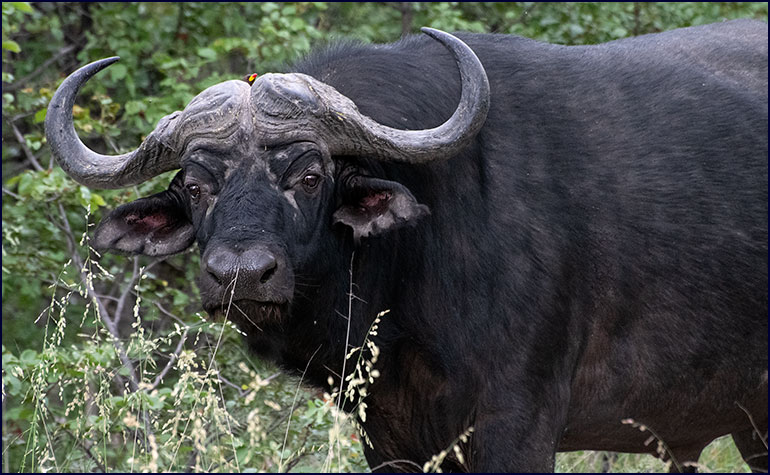
African Buffalo
|
We saw a few more buffalo and
another herd of giraffes. An elephant bull in musth
blocked the road. Gee gunned the engine to make him yield right of
way; he moved off in annoyance and vanished mysteriously into the
underbrush.
Around four o'clock the rain started again and we pulled
out the ponchos. It wasn’t bad though - the temperature was
pleasant and we didn't get wet under our ponchos. A call came over
the radio; a guide needs help – his vehicle has fallen through
Third Bridge and is stuck. Gee turned to us and asked, shall we
go? Yes, of course – helping each other out here in the bush is
the way it is done.
But before we got far, a ranger
flagged us down and said to follow him to see something close and
amazing. Gee followed; I got the impression he did not want to
tell the ranger of our intended rescue mission - the guides seem
to stick together and help each other. The vehicle stuck in the
bridge would have to wait.
We followed the ranger past a park gate to a huge spreading
tree. Looking up to where he indicated, we could see a female
leopard lying on a branch above us. The carcass of a male impala
hung a few feet from her; those long horns must have made it even
harder to drag him up there. The
leopardess watched us uncertainly; soon we realized why – there
was a cub on a high branch above her.
Camouflaged among the leaves, the baby leopard peeked out
at us shyly. He looked to be 3 or 4 months old, and was impossibly
cute. Gee told us that leopards usually have only one baby at a
time, or occasionally twins. We couldn’t believe our luck; two
more leopards for our list. So much for them being hard to find
this time of year.
We resumed the rescue. Gee drove
fast – the guide stuck on the bridge was waiting for us. We
bumped quickly along the sand tracks. A big, beautiful kudu bull
stood by the road but we did not pause. Gee briefly stopped at our
new camp to drop off the luggage trailer. BD and KK looked aghast
when we drove in, hours early, as they had not finished setting up
camp - they were relieved when we dropped the trailer and took off
again
.
We came to Third Bridge, a long
rickety wooden bridge across a marshy river. It was built from
roughhewn poles about eight inches in diameter, laid side by side
and set lengthwise across the span. It was in a state of
disrepair, with places where the poles buckled upwards, or were
rotted out altogether. It sagged noticeably in the middle. A green
caution sign advised us:
DO NOT SPEED OVER BRIDGE.
|
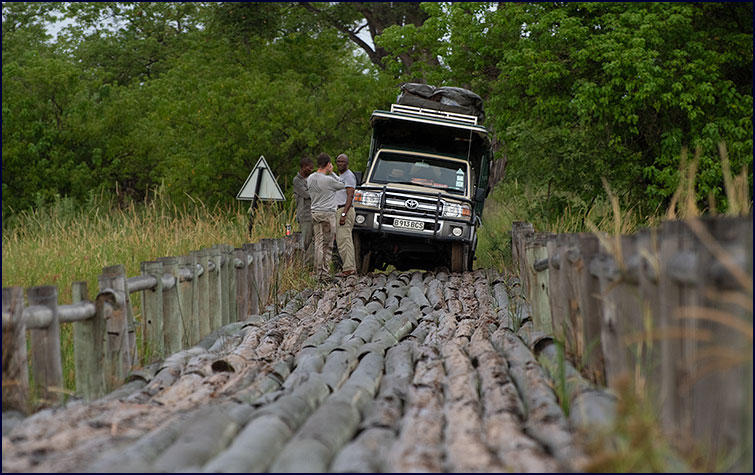
Stuck on Third Bridge
|
Part way across the bridge sat another land cruiser. It was
leaning alarmingly, with the rear wheels on one side stuck down
through a hole in the bridge. The guide seemed glad to see Gee;
his guests were a group of Germans, and they were not happy.
Deciding the truck would need to be pulled forward, Gee
drove around the swamp to the other side of the bridge. We got out
and he backed his vehicle over the long bridge. We did wonder, if
one truck fell through, was it wise to drive a second onto the
bridge? But all went well, and Gee towed the other vehicle to firm
land. Our rescue mission for was a success!
|
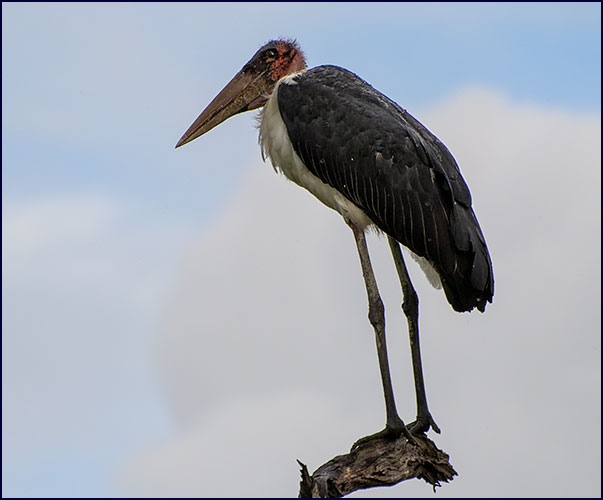
Marabou Stork |
As we started heading slowly back toward camp, the clouds
darkened and the rain started up again.
A Sausage Tree stood alone on the plain, its huge seed pods
hanging down like hundreds of fat sausages – many of the animals
eat these pods. A Marabou Stork sat high in a dead tree; these
huge storks are quite possibly the ugliest bird alive.
In contrast, a grey heron was similarly silhouetted against
the sky, all elegant beauty and graceful lines. A flock of
spurwing geese flew overhead, and the lonesome cry of a fish eagle
floated on the air. We paused to watch an elephant feeding.
We rolled into camp at six-thirty. It was the same campsite
we’d had in 2015. It had been dry then, but now there was a
waterhole down from the tents, and we could see birds and impala
around it. There was a kudu and a buffalo skull by a tree behind
our tent, and a monkey climbing in the tree beside Mary’s tent.
Our towels were on our beds, folded into shapes like impala and
buffalo heads.
|
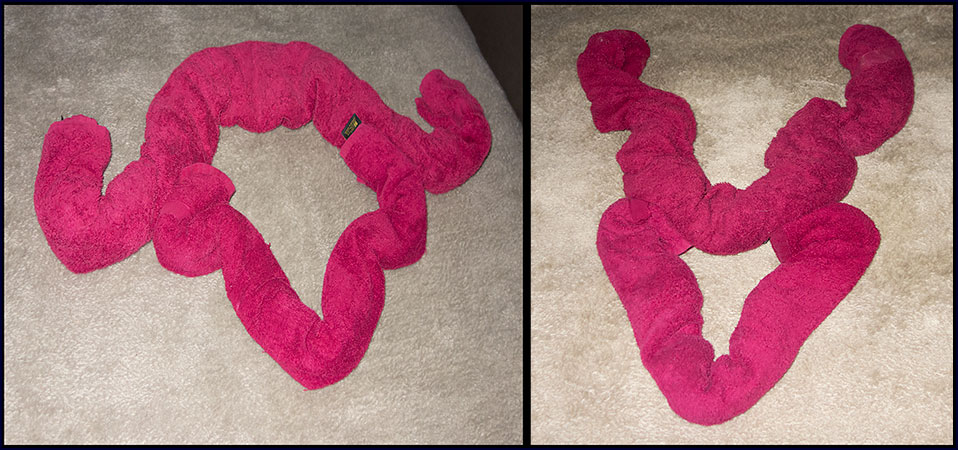
Towel Art on our beds
|
As the rain stopped and the clouds cleared, an amazing
double rainbow stretched out across the pink and purple sunset
sky. We sat by the fire and watched the brilliant display with
appreciation.
At dinner, we noticed porcupine
quills had been added to the bicycle sculpture on the table. Life
had prepared a lovely birthday cake for Mike; it was one day early
but we didn't let on.
February
14
It was raining softly as we set
out in the morning. We were scheduled to go for a boat ride on the
Xakanaxa Lagoon. A female kudu stood in the morning mist and
watched us pass, her thin white stripes blending with the tall
grass in the pre-dawn light. A herd of impala were running back
and forth. We saw no predators; the impala seemed to be running
just for the joy of it. A Giraffe stood in the half-light among
the trees; she had a small baby, the youngest we had seen so far.
Baby giraffes’ necks appear thick for their size, and their
heads proportionally tiny.
|
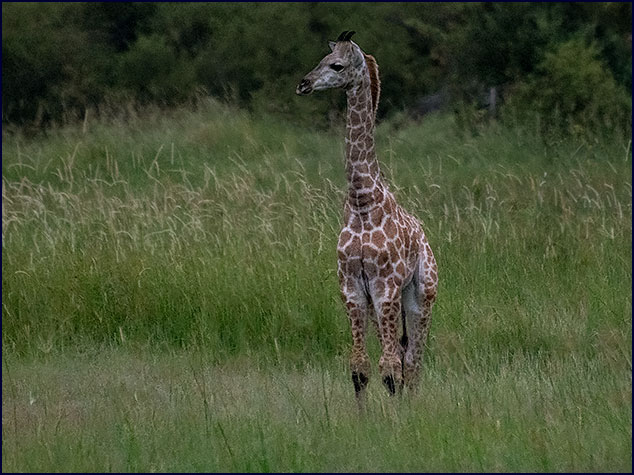
Baby giraffe |
We got to the boat dock about 7:15, and boarded a
medium-sized covered motor boat. Our driver and boat guide was
named Fly. Gee stayed behind in the land cruiser to watch the
belongings, and we hoped he might get a nap – with our penchant
for long game drives we had been working him pretty hard.
Gee laughingly said maybe we would
get lucky and see a situnga; he explained that these are very rare
antelopes that live in the marshy areas along the river. He told
us they are very elusive, and nobody ever sees them.
It was raining fairly hard by the time we got underway. Fly
navigated the winding channels through the tall thick reeds and
brought us out to a huge lagoon.
Lily pads lined the way, and the grass was laden with water
droplets. It was very serene, and seemed worlds away from the
bushveld we had become used to.
We watched a pied kingfisher as he
hovered above the water like a giant hummingbird; he would
suddenly dive straight down and hit the surface with a huge
splash, coming up more often than not with a fish.
|
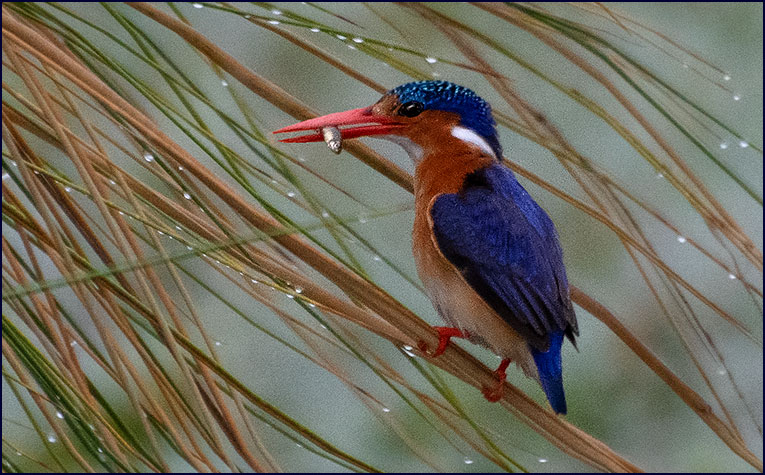
Malachite Kingfisher
|
We were able to get quite close to a beautiful little
Malachite Kingfisher sitting in the reeds. He was holding a tiny
silver fish in his beak. I was able to get a photo that not only
showed the light in his eye (Gee’s standard for a good bird
photo); you could just about see the light in the fish’s eye as
well.
There were quite a few new birds for us on the boat ride,
including the African Stonechat, a Black-crowned Night Heron, a
Black Crake and a Red-collared Widow Bird. Pygmy Geese floated by
us, and we saw a Purple Heron when we stopped for tea.
Suddenly we saw a large swell rising up ahead of us like a
great wave. Just as we were wondering what it could possibly be,
an angry hippo plunged up out of the water, leaping and pushing a
bow wave ahead of him. Then he turned and faced us, moving closer
with his face barely out of the water as he scrutinized us. He
glared at us a while, then submerged with a big exhalation and
pushed up a few more waves. It was very impressive. He did not
want us there, and let us know it in no uncertain terms.
Looking out across the wet fields, we could see an antelope
grazing in the tall grass. At first we thought it was a lechwe,
but it didn’t look quite right. Fly looked amazed, and told us
it was a Situnga! Very rare, he said. Gee would never believe it!
We were not real close, but we could see it well through the
binoculars, and I was able to get a photo for proof.
|
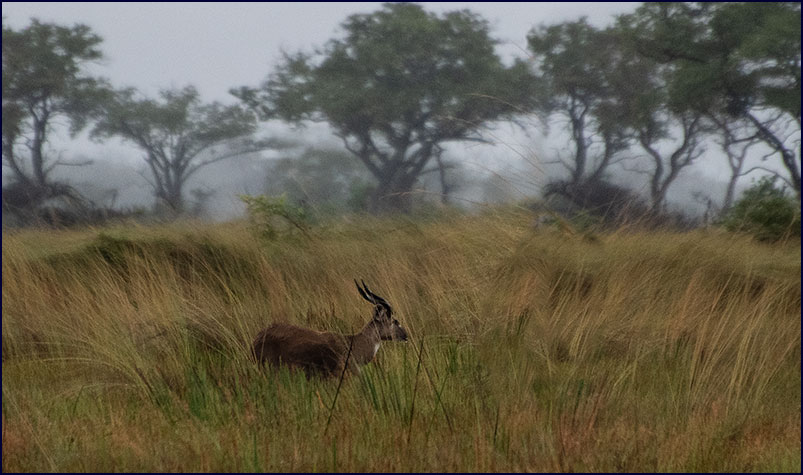
The rare and elusive Situnga |
As we finished our loop route and headed back, pygmy geese
swam among the lily pads, and a goliath heron flew up out of the
reeds on slow silver wings. We were back with Gee at 9.30. I
pulled out my camera and showed him the picture of the situnga,
and feigning innocence asked him, ‘Is this a lechwe?’ My
god! he exclaimed.
We were on the road again by ten. We watched as a group of
young impalas exercised, racing in circles at top speed. A pair of
African Green Pigeons perched in a tree above us.
|
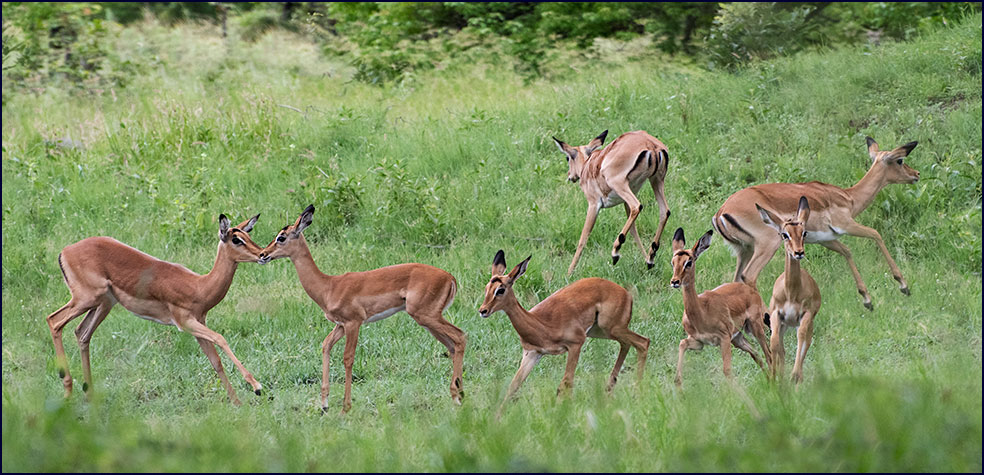
Impalas getting their daily exercise.
|
A vervet monkey sat it a cleft in
a tree, watching us. There were several young monkeys up in the
branches, jumping from limb to limb, swinging and romping. They
were quite daring, and put on an acrobatic show. Several times
they looked like they were starting to fall, but then nimbly
caught themselves. Two mothers with small babies lounged by the
roadside; the youngsters pulled and jumped at their moms, begging
for attention.
|
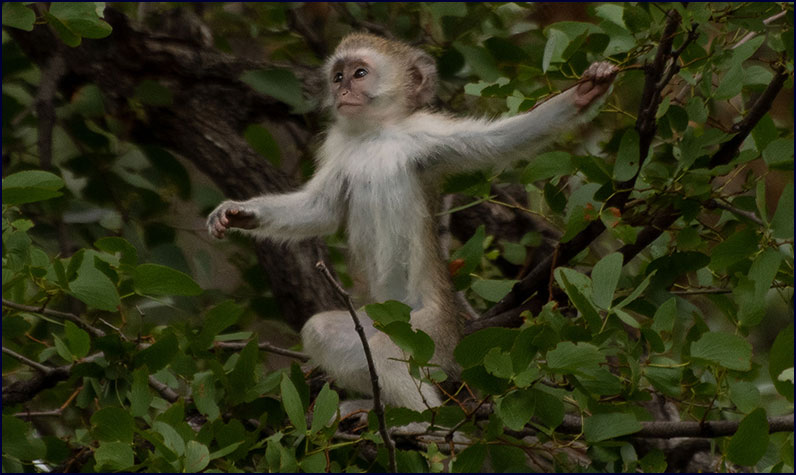
Vervet Monkey
|
We drove through an area of beautiful large trees. Gee
identified Marula trees, Jackleberry and Ebony trees with their
near-black trunks. There were many large mopanes as well; we
marveled again at how tall and lovely they grow when the elephants
don’t keep them bitten off to nubs. The mopane leaves are
butterfly-shaped, and reddish at the tips.
Gee pointed out a strangler fig on
a large mopane tree; these thick limb-like vines will kill there
host tree. Birds deposit the strangler fig seed on the tree, and
the vine grows from there, stretching both up to the branches and
down to the ground where it roots. The area was scattered with
huge termite mounds; several of them were twenty feet tall.
There were some pretty wildflowers here and there; Jineen
was especially drawn to them. Many of them went unidentified, but
Gee usually knew what they were if we asked him. There were wild
hibiscus with yellow flowers, and Devil’s Claw, the national
flower of Botswana – Gee told us these pretty little pink
wildflowers are used to treat venereal disease. He pointed out a
milkweed plant, quite different from those at home, and told us
the monarch butterflies feed on them. As always we saw many birds;
the Black Capped Bul-bul, Puff-backed Shrike and Grey-backed
Camaroptera were a few of the new ones.
|
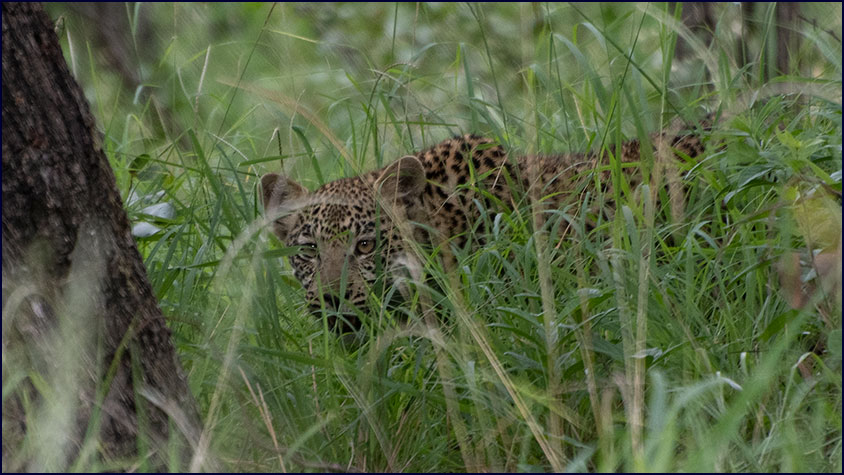
The baby Leopard
|
We went back to check on the leopards we had seen in the
tree the evening before. The mother was on the ground, just
leaving as we approached. Gee said she is very shy. She looked at
us through the grass and disappeared silently into the
undergrowth. Then we saw the baby, half hidden behind the tree. He
played peekaboo with us, peering out from one side of the trunk
and then the other, and then he moved to a different tree and
repeated the performance. After a while he quietly moved off
through the brush in the direction his mother had gone.
A troop of baboons moved by; they seemed shy and wary.
Several big males were barking noisily, loud and aggressive. Two
babies were riding upside down under their mothers’ bellies,
with their tails sticking out between her hind legs.
One baboon mother was sitting holding her small baby in her
lap and hugging him to her chest. The little one looked straight
at us and made eye contact, unlike the adults who always seem to
avert their gaze. The baby baboons look very different from the
grownups. While the adults have longer snouts and dark faces, the
infants have hairless pink faces fringed with dark fur, and they
resemble a baby chimpanzee – or even a baby human. I find most
baby animals irresistibly cute, but there was something slightly
disturbing about those little pink baby baboon faces staring at
us. Gee said the males can be dangerous; if you are on foot
don’t walk among them.
We saw a hint of motion in the dappled forest shadows. We
got a quick glimpse of a male leopard as he walked through the
trees hunting. We searched for him through the thickets, but could
not find him again. Gee told us that leopards are the most active
of all the big cats, and they will hunt all day if they need to.
They are his favorite among the cats.
We were now up to seven leopards.
Unbelievable! Keeping with a long-standing Dawson Family
tradition, I made up a bad limerick for the occasion:
The leopard is
elusive to see
They hide in tall grass, says Gee
But when we saw seven
We thought it was heaven
Especially when they took dinner up a tree
|
A herd of female impala were walking along near the road. A
bit further on we saw a large male impala enthusiastically
thrashing a sapling; he shredded the bark as he raked the base of
his horns up and down the trunk. It looked as if he was fighting
with the small tree. He kept at it for some while; we didn’t
know if he was scratching an itch or taking out his anger on the
shrubbery. Gee said he has a scent gland on his head, and was
marking his territory. Finally the impala was finished flaying the
tree and bounded away.
We stopped to spend a little time with a very pregnant
giraffe. She browsed in the trees sedately. Her stomach was
enormous; she must have been close to her due date. Gee told us
the babies are born in September and October. We continued back to
camp, getting in for lunch at 12:30.
There was a waterhole several hundred yards from camp, set
in a large open glade among the tall trees. Many dead tree trunks
stood around it, drowned from flooding when shifts in the earth
had changed the watercourse. A group of impala were chasing each
other around, and we could see Egyptian geese and egrets at the
edge of the water. A dozen zebras filed down to drink.
Mary and I walked across the glade
toward the waterhole, but we were not quite sure if it was safe to
stray so far from the tents. Suddenly the impalas started snorting
their alarm calls – uh oh, is there a leopard? No, we realized,
they are snorting at us. We headed back to the tents.
|
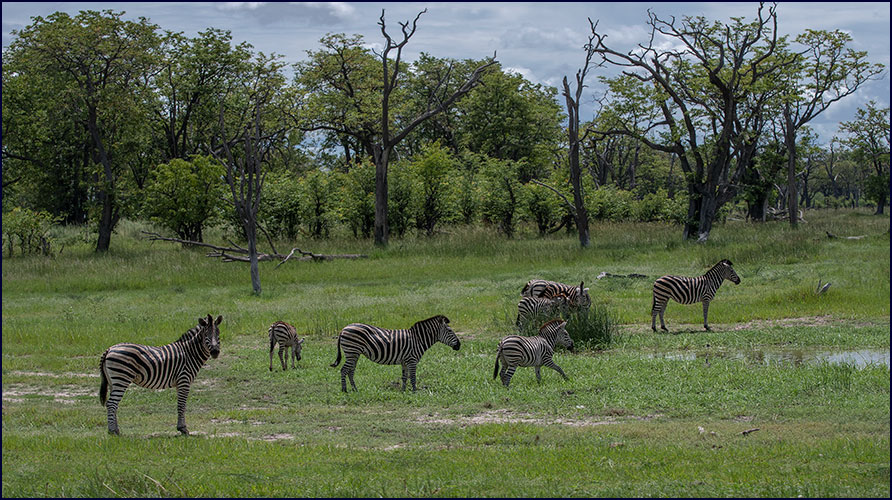
The waterhole at camp
|
A spectacular Burchell's starling posed on a log outside my
tent for photos, his iridescent blue feathers gleaming in the sun.
He tilted his head and looked at me beseechingly, hoping for
handouts. Mindful of what Gee had told us about feeding the birds,
I gave him nothing.
|
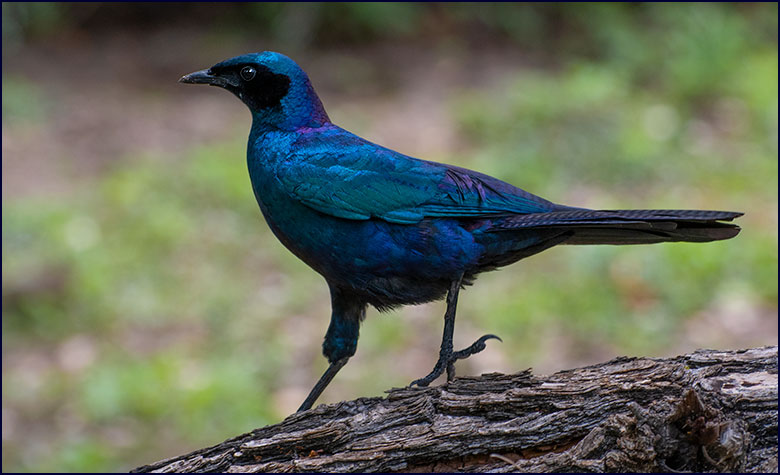
Burchell's Starling
|
Mary’s tent was the last one in line, and that was where
the action was. Two young vervet monkeys climbed in a tree,
romping up and down the trunk and tussling with each other. One of
them chewed on a stick while the other tried to wrestle it away.
A male red-billed hornbill sat on a limb right in front of
Mary’s tent. He was holding a large grub in his beak; then he
flew to a hole in the tree and reached his head in. We realized
there was a hornbill nest in the hollow part of the tree, and the
male was feeding his mate.
Gee had told us about the
hornbills’ mating habits before: The female hornbill squeezes
through an opening into a hollow in a tree, then molts, and uses
all of her feathers to make a nest. The male seals her in, leaving
only a small hole which he feeds her through. She stays sealed in
the nest until the eggs hatch and the babies are big enough to
come out, and until her feathers have grown back. I had only half
believed this scenario until I saw it for myself!
|
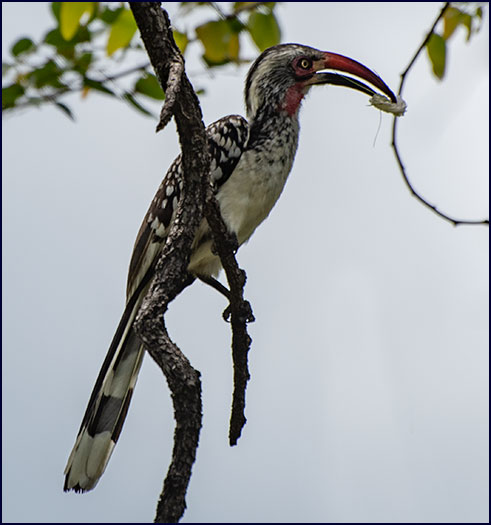
Red-billed Hornbill
|
A bit later I had just finished my bucket
shower when I heard Natalie quietly call to me, “There are
zebras behind the tent!” And indeed there were, right
behind the tent.
A family group of eight wandered
by leisurely. There were four adults, a couple of yearlings, and
two foals, one of them very small. They stopped often to nibble
grass, and for the youngsters to scratch each other’s backs. The
small baby was very curious about a vervet monkey that was in the
path, following it until the monkey ran off. A big stallion rubbed
his withers against a tree trunk.
The zebras grazed their way down to the waterhole, pausing
often but not seeming to notice us. They drank their fill, and
then stood by the water a long time. The babies rubbed one another
while the adults yawned copiously - they looked like they were
laughing. After a while they all moved
back toward the camp. This time they did notice us; they stopped
and snorted repeatedly. The big stallion looked at us warily and
dared us to mess with his herd.
The mare with the small foal stopped and stared at us; the
baby nuzzled her and nursed a little. They were so beautiful, like
magical creatures from a dream. Eventually they drifted off and
disappeared into the trees. It was the best baby zebra sightings
of the whole trip, right here within 20 feet of our tents. I
thought to myself, ‘I love
this camp!’
We went back out around 2:30. Unfortunately Mary was not
feeling well, so she sat out this drive. Right away we came across
two female kudus. One of them stood quite close to the road and
watched us with interest; I used this opportunity to get some
close-up face shots of her.
|
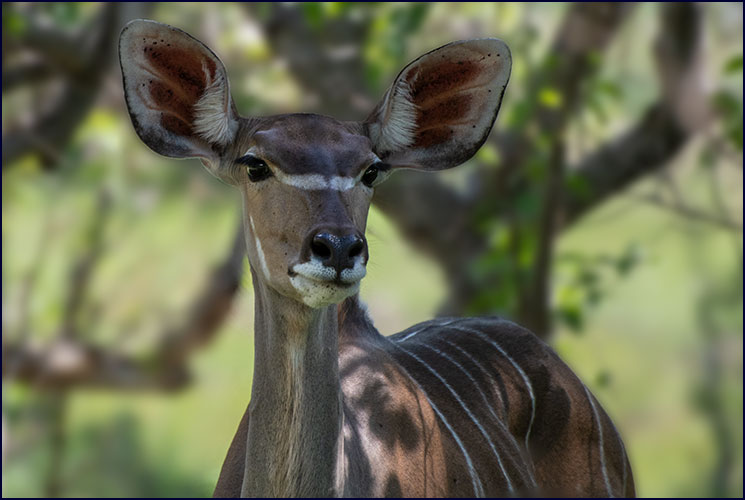
Female Kudu
|
We skirted along the edge of a permanent lagoon. A large
hippo was walking along the shore, out of the water; he was wet
with mud and slime. He turned his back to us and showed us his
amazing round rump.
A pair of Reed Bucks stood, appropriately, in the reeds.
These medium-sized antelopes look a bit like the red lechwe, but
they are a paler fawn color with refined faces, and are built
level, not down-hill like the lechwes. The reed bucks are far less
numerous; we saw them only twice on the whole trip.
A
baby croc was out sunning himself beside a small waterhole. The
babies are so much brighter and prettier than the adults; this one
was a mottled green and brown color, and looked clean and fresh -
the adults are the grey-brown color of mud.
There was a huge hamerkop nest in the croft of a tree.
These unusual birds will use any materials they can find to build
their nests, including sticks and branches, trash, discarded
clothing and old shoes. Sometimes kids will break open the
hamerkops nest to see what they find, but this is considered very
bad luck.
We came across a big male hyena
sleeping in the sun. His spotted coat was a light chestnut brown
color - I thought this unusual, but then again I’m not sure I
had ever seen a hyena in full sunlight before. Several times he
raised his head, looked around drowsily, and lay back down flat
again. Finally got up slowly and walked away, probably to find a
more private spot to finish his nap.
A lone wildebeest bull stood in the road gazing at us; he
was there alone guarding his territory. His face was covered in
mud, though the rest of him was pretty clean. The soft black
stripes across his neck and ribcage stood out in the afternoon
sunlight.
|
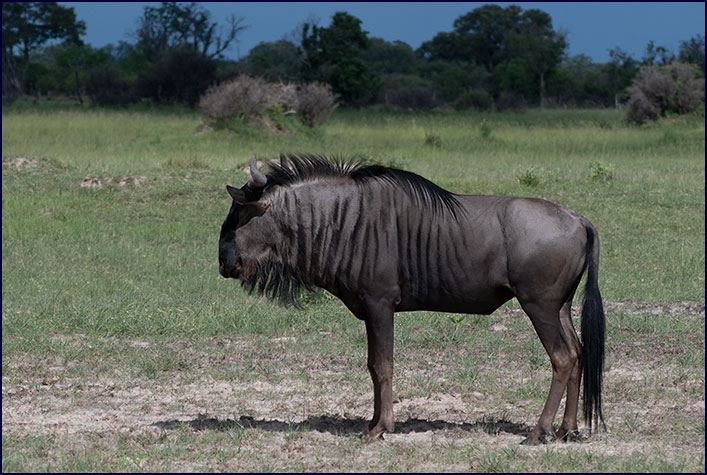
Wildebeest
|
Around four o'clock we came to a large termite mound with a
few trees around it, at the edge of a wide field. Gee pointed and asked us,
‘Do you recognize this place?’ And then suddenly I did! This
was the spot where we had we rescued a Dutch family back in 2015.
They had been self-driving and camping, and had gotten stuck –
when we found them they had been out there for five days. Being
winter the Okavango Delta had been flooded from the Angola rains,
and the field had been under several feet of water. This was the
termite mound where the family had their fire. We could still see
the deep tire ruts where their truck had been stuck.
We had a nice visit with a pair of giraffes. The big male
stood close to the road gazing at us while a particularly
precocious oxpecker climbed on his head and pecked at his horny
knobs. We passed several more groups of giraffes; from time to
time they would take off running in their slow-motion rollicking
canter.
Looking up, we saw a pair of
saddle-billed storks flying high above us, backlit, the white
edges of their wings glowing in the sun. These huge birds are
graceful in flight.
A pair of fish eagles looked down
on us from a high tree. One of them called out; his soul-searching
cry gave me shivers up my spine. The call of the fish eagle is
often referred to as “The Call of Africa.” The two raptors
took to the air and sailed off on powerful wings.
|
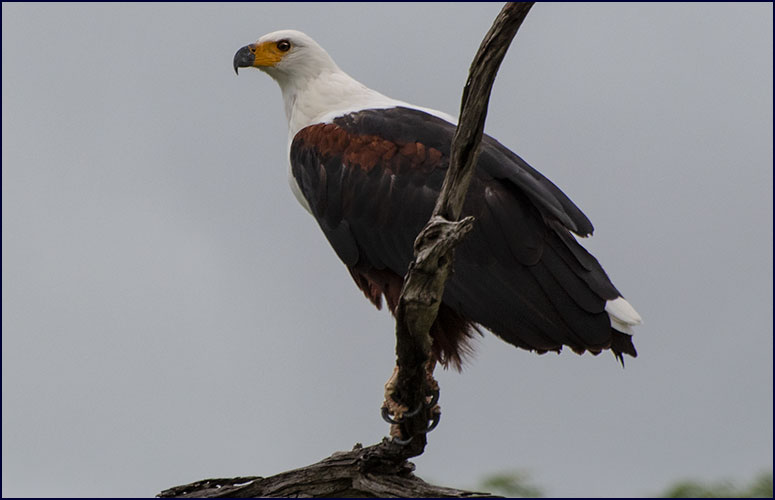
Fish
Eagle
|
We saw something moving in the grass - it was a Water
Monitor Lizard. He must have been four feet in length, and had
attractive, patterned black and yellow scales. He walked along
quickly and came to an old termite mound. For a moment he looked
like he might go down a hole, but then he thought better of it. He
raised his head and looked around, regarding us with beady eyes.
He was quite beautiful.
A group of male impalas were grazing; the biggest one
appeared to be the leader of this bachelor herd. He walked regally
along, holding his head high as he looked around watchfully.
Because they are so common it is easy to take the impalas for
granted, but they really are exquisitely beautiful.
|
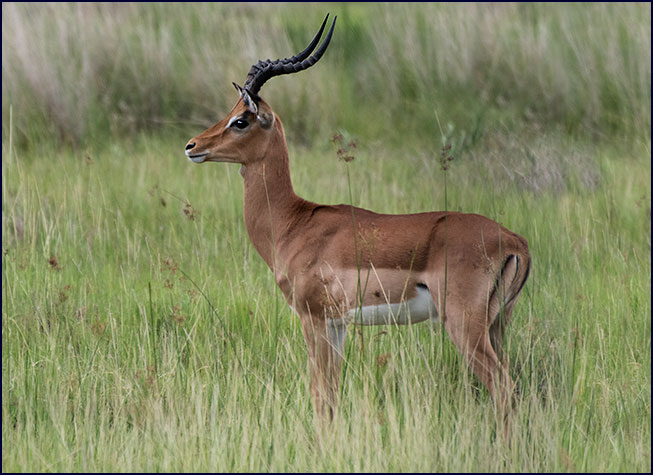
Impala buck
|
We saw a pair of Monarch Butterflies on a mopane tree.
Similar to our monarchs but smaller, they were a bright orangey
chestnut color, and their wings and bodies were rimmed were with
black and white polka dots. A heavily pregnant banded mongoose
scurried though the underbrush.
On each drive we would see many animals such as giraffes,
zebras, impala, and lechwe, as well as birds by the dozen, so I am
not necessarily recording every sighting of the more common
wildlife. But as I go through my thousands of photographs and look
at the times they were taken, other than occasional stretches on
travel days it was rare that more than five minutes went by
without seeing something worth photographing.
|
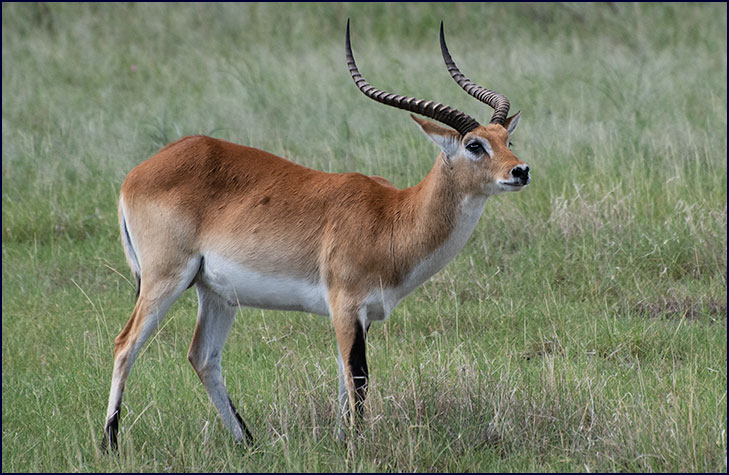
Red Lechwe
|
Around five o'clock we came to a blackened area where a
fire had swept through a month prior. Green grass grew on either
side of a narrow black swath where everything had been burned
away. A mother zebra stood on the edge of the burned area, nursing
her foal.
We were driving along when suddenly Tara called out,
“Look, there is a big frickin’ lizard!” We quickly realized
it was not a lizard but a crocodile, and a big one at that, quite
far from the water. Realizing we had seen him, the crocodile took
off and ran from us. I expected him to crawl, but instead he
lifted up on his legs, well off the ground, and moved with
surprising speed.
He went fast over a small ridge, heading for a nearby
lagoon, and Gee followed - but as the croc topped the rise he
found to his dismay there was no water in the lagoon. Changing
tactics, he gave camouflage a try. He stopped under a tree and
froze, and did not move a muscle or bat so much as an eyelash
again. We pulled up close to look at him; he had an amazing
serpentine row of jagged teeth, and surprisingly beautiful green
eyes.
Hippos can hold their breath for
six minutes, Gee told us, but crocs can hold theirs for up to an
hour. In Africa,
dinosaurs and elephants walked the same territory, but separated
by 200 million years. Crocodiles
were around during the time of dinosaurs, and survived all those
millenniums unchanged. The dinosaurs are long gone, but the crocodiles are still here.
|